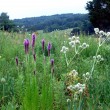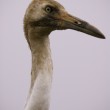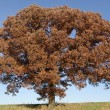Natural History in Monroe St. Clair and Randolph Counties Illinois
Enduring Natural Rhythms Toll in Springtime Wonders
A March morning in the bluffs is only as drab as one who walks in it without looking skyward, for, in March, the sky-clock clearly is set at springtime. Trumpeting skeins of geese — Greater White-fronted speckle bellies, Ross’s, Snowies, and Canadas — winging through the skies, draw eyes and hopes upwards: northward bird migration […]
Winter Hibernation: Living Through the Cold
Our bluff lands, in winter, take on a stripped-down, emptied-out aspect. The trees, now shorn of all but the most stubbornly clinging dried remnants of last-year’s lush growth, stand as mute skeletons to the winter winds. Most birds, no longer defending breeding territories with loud song, offer only soft location calls as they forage for […]
Prairie Patches Are Small Relics of Once Vast Ecosystems

Dennis FitzWilliam, Clifftop Illinois, the “Prairie State,” once was a part of a vast grassland, stretching from Indiana to Nebraska, from Texas to Saskatchewan, called the tallgrass prairie. In 1800, 22 million acres of Illinois were tallgrass prairie and 14 million acres were forest. Millions of years ago, because of the Rocky Mountain […]
They ARE Whoopers!

Dimly seen through a dreamlike fog and mist, the six huge birds are unmistakably, absolutely, incontrovertibly juvenile Whooping Cranes: five-foot tall, white-splotched-with-brown, black-tipped-winged wonders and the rarest bird species in North America. What are they doing in Monroe County? That, is, besides wading and eating the occasional frog or bite of corn as they slowly […]
The Nature of Holiday Traditions
Much of the upcoming holiday season’s traditions are based on customs brought from the past and honored in the present. Of these, perhaps the most potent are those that remind us of our connections with the natural world and the evergreen assurance that even in winter’s desolate landscape of still quiet, life and warmth will […]
Trees and the Structure of Life…The Understory
As the dominant trees of our bluffs shine in autumn’s sun, creating a glowing tapestry of color, they also provide a rich food source for wildlife. Mast is the broad term for various nuts and fruits produced by trees and shrubs. There are two kinds: hard mast and soft mast; both are crucial in sustaining […]
Trees and the Structure of Life…The Overstory

Trees and mankind make history together. Both bring definition to a place, adding an unmistakable presence. In the early 1600s, in pre-European settlement times, 70% of the United States east of the Mississippi River was forested. Its been said that an Eastern Gray Squirrel could have departed the Jersey Shore and arrived at the Mississippi […]
Asters Give Bluff Scape a Final Splash of Color While Hawks Soar Overhead
When our bluff’s grasslands, woodland edges, and cropfields have all but given up for the season in September and are turning to burned-out colors, along come asters, giving the bluff scape a final splash of whites, purples, and blues before winter sets in. There are 120 species of asters in North America; 38 in Illinois; […]
Dog Day Flowers Paint Bluffs with Golden Hues
Early European settlers unpacked naming traditions along with all the cultural baggage they brought from their home countries. European naming echoes still in descriptions of August as the “dog days” of summer and the August moon as “dog days moon.” As apt as the thought of dogs panting through the hottest days of the year, […]
Prairie State’s Remaining Prairies Cling to Bluffs
Illinois, the Prairie State, once was part of a vast grassland, covering most of central North America, called the tallgrass prairie. In pre-European settlement times, Illinois consisted of approximately 22 million acres of prairie — about 60 percent of the state’s land — and 14 million acres of forest. At the time of European settlement, […]
